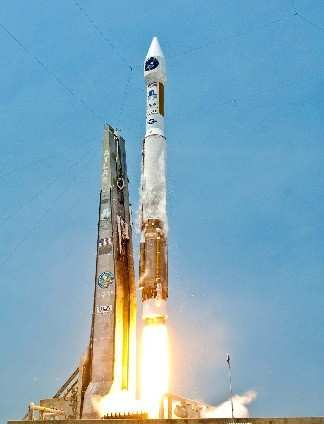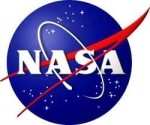Tue, Jul 19, 2011
Atlas V May Be Next NASA Manned Launch Vehicle
Through a new agreement, United Launch Alliance (ULA) will
provide technical information to NASA about using the Atlas V
rocket to launch astronauts into space. The announcement was made
Monday at the agency's Kennedy Space Center in Florida. "I am truly
excited about the addition of ULA to NASA's Commercial Crew
Development Program team," NASA Administrator Charles Bolden said.
"Having ULA on board may speed the development of a commercial crew
transportation system for the International Space Station, allowing
NASA to concentrate its resources on exploring beyond low Earth
orbit."

ULA Atlas V Launch
NASA and ULA’s unfunded Space Act Agreement (SAA) requires
ULA to provide data on the Atlas V, a flight-proven expendable
launch vehicle used by NASA and the Department of Defense for
critical space missions. NASA will share its human spaceflight
experience with ULA to advance crew transportation system
capabilities and the draft human certification requirements. ULA
will provide NASA feedback about those requirements, including
providing input on the technical feasibility and cost effectiveness
of NASA's proposed certification approach.
"This unfunded SAA will look at the Atlas V to understand its
design risks, its capabilities, how it can be used within the
context of flying our NASA crew and maturing ULA's designs for the
Emergency Detection System and launch vehicle processing and launch
architectures under a crewed configuration," said Ed Mango, NASA's
Commercial Crew Program manager.
The majority of the work will be completed by the end of this
year. As part of the agreement, NASA will:
- Participate in milestone and technical review briefings and
provide technical feedback on milestone completion.
- Assist in identification of risks and possible mitigation
strategies.
ULA will:
- Continue to advance the Atlas V CTS concept, including design
maturation and analyses.
- Conduct ULA program reviews as planned.
- Perform a Design Equivalency Review.
- Develop Hazard Analyses unique for human spaceflight.
- Develop a Probabilistic Risk Assessment.
- Document an Atlas V CTS certification baseline.
- Conduct Systems Requirements Review.

"We believe this effort will demonstrate to NASA that our
systems are fully compliant with NASA requirements for human
spaceflight," said George Sowers, ULA’s vice president of
business development. "ULA looks forward to continued work with
NASA to develop a U.S. commercial crew space transportation
capability providing safe, reliable, and cost effective access to
and return from low Earth orbit and the International Space
Station."
In 2010, NASA awarded $6.7 million to ULA to accompany its own
$1.3 million investment to develop an Emergency Detection System
prototype test bed. The EDS will monitor critical launch vehicle
and spacecraft systems and issue status, warning and abort commands
to crew during their mission to low Earth orbit. EDS is the sole
significant element necessary for flight safety to meet the
requirements to certify ULA's launch vehicles for human
spaceflight.
More News
Circle To Runway (Runway Number) Used by ATC to inform the pilot that he/she must circle to land because the runway in use is other than the runway aligned with the instrument appr>[...]
Aero Linx: National Aviation Safety Foundation (NASF) The National Aviation Safety Foundation is a support group whose objective is to enhance aviation safety through educational p>[...]
At Altitude Of About 250-300 Ft Agl, The Airplane Experienced A Total Loss Of Engine Power On November 6, 2024, at 1600 central standard time, a De Havilland DHC-1, N420TD, was inv>[...]
From 2009 (YouTube Edition): Three Hour Flight Was 'Flawless' -- At Least, Until Mother Nature Intervened For anyone who loves the aviation business, this was a VERY good day. Afte>[...]
Also: AMA Names Tyler Dobbs, More Falcon 9 Ops, Firefly Launch Unsuccessful, Autonomous F-16s The Air Force has begun ground testing a future uncrewed jet design in a milestone tow>[...]
 ANN's Daily Aero-Term (05.05.25): Circle To Runway (Runway Number)
ANN's Daily Aero-Term (05.05.25): Circle To Runway (Runway Number) ANN's Daily Aero-Linx (05.05.25)
ANN's Daily Aero-Linx (05.05.25) NTSB Prelim: De Havilland DHC-1
NTSB Prelim: De Havilland DHC-1 Classic Aero-TV: The Boeing Dreamliner -- Historic First Flight Coverage
Classic Aero-TV: The Boeing Dreamliner -- Historic First Flight Coverage Airborne-NextGen 05.06.25: AF Uncrewed Fighters, Drones v Planes, Joby Crew Test
Airborne-NextGen 05.06.25: AF Uncrewed Fighters, Drones v Planes, Joby Crew Test




